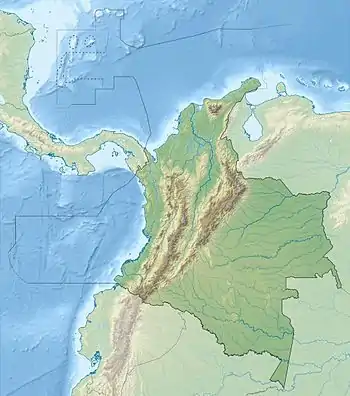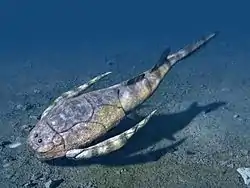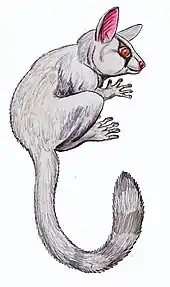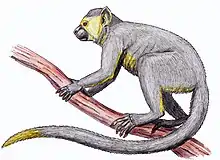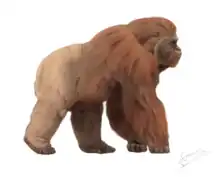| Miocallicebus | |
|---|---|
| Scientific classification | |
| Domain: | Eukaryota |
| Kingdom: | Animalia |
| Phylum: | Chordata |
| Class: | Mammalia |
| Order: | Primates |
| Suborder: | Haplorhini |
| Infraorder: | Simiiformes |
| Family: | Pitheciidae |
| Subfamily: | Callicebinae |
| Genus: | †Miocallicebus Takai et al. 2001 |
| Type species | |
| †Miocallicebus villaviejai | |
Miocallicebus is an extinct genus of New World monkeys from the Middle Miocene (Laventan in the South American land mammal ages; 13.8 to 11.8 mya). Its remains have been found at the Konzentrat-Lagerstätte of La Venta in the Honda Group of Colombia. The type species is Miocallicebus villaviejai.[1]
Etymology
Miocallicebus is derived from the Greek name for the modern genus of titis, Callicebus, with the prefix Mio for Miocene. The species epithet refers to Villavieja, a village close to where the fossil remains were found.[2]
Description
Fossils of Miocallicebus were discovered in 1997 during a field study executed by researchers at the Primate Research Institute of Kyoto University. The specimen consists of a right maxillary fragment preserving a root of M1, a complete M2, and a badly damaged M3,[3] discovered at the Bolivia Site in the Tatacoa Desert of Huila, south-central Colombia.[2] The genus has not been found in the "Monkey Beds" of La Venta.[4] The fossil remains were uncovered just above the Tatacoa Sandstone Beds of the La Victoria Formation, which has been dated to the Laventan with a range from 13.86 to 12.38 mya.[2]
The estimated weight for Miocallicebus, considered similar to but much larger than the extant genus Callicebus,[5][6] is 1,500 grams (3.3 lb).[7] However, it may be phylogenically nestled within Callicebus,[8] which would warrant a replacement of the species to be in that genus.
The evolutionary split between Pitheciidae of Cebupithecia from the Honda Group and Callicebus, including Miocallicebus, has been placed at 15.2 mya.[9]
Habitat
The Honda Group, and more precisely the "Monkey Beds", are the richest site for fossil primates in South America.[10] It has been argued that the monkeys of the Honda Group were living in habitat that was in contact with the Amazon and Orinoco Basins, and that La Venta itself was probably seasonally dry forest.[11]
See also
References
- ↑ Miocallicebus villaviejai at Fossilworks.org
- 1 2 3 Takai et al., 2001, p.292
- ↑ Takai et al., 2001, p.291
- ↑ Wheeler, 2010, p.137
- ↑ Takai et al., 2001, p.294
- ↑ Tejedor, 2013, p.28
- ↑ Silvestro et al., 2017, p.14
- ↑ Silvestro et al., 2017, p.26
- ↑ Takai et al., 2001, p.304
- ↑ Rosenberger & Hartwig, 2001, p.3
- ↑ Lynch Alfaro et al., 2015, p.520
Bibliography
- Lynch Alfaro, Jessica W.; Liliana Cortés Ortiz; Anthony Di Fiore, and Jean P. Boubli. 2015. Special issue: Comparative biogeography of Neotropical primates. Molecular Phylogenetics and Evolution 82. 518–529. Accessed 2017-09-24.
- Rosenberger, Alfred L., and Walter Carl Hartwig. 2001. New World Monkeys. Encyclopedia of Life Sciences _. 1–4. Accessed 2017-09-24.
- Silvestro, Daniele; Marcelo F. Tejedor; Martha L. Serrano Serrano; Oriane Loiseau; Victor Rossier; Jonathan Rolland; Alexander Zizka; Alexandre Antonelli, and Nicolas Salamin. 2017. Evolutionary history of New World monkeys revealed by molecular and fossil data. BioRxiv _. 1–32. Accessed 2017-09-24.
- Takai, Masanaru; Federico Anaya; Hisashi Suzuki; Nobuo Shigehara, and Takeshi Setoguchi. 2001. A New Platyrrhine from the Middle Miocene of La Venta, Colombia, and the Phyletic Position of Callicebinae. Anthropological Science, Tokyo 109.4. 289–307. Accessed 2017-09-24.
- Tejedor, Marcelo F. 2013. Sistemática, evolución y paleobiogeografía de los primates Platyrrhini. Revista del Museo de La Plata 20. 20–39. Accessed 2017-09-24.
- Wheeler, Brandon. 2010. Community ecology of the Middle Miocene primates of La Venta, Colombia: the relationship between ecological diversity, divergence time, and phylogenetic richness. Primates 51.2. 131–138. Accessed 2017-09-24.
Further reading
- Fleagle, John G., and Alfred L. Rosenberger. 2013. The Platyrrhine Fossil Record, 1–256. Elsevier ISBN 9781483267074. Accessed 2017-10-21.
- Hartwig, W.C., and D.J. Meldrum. 2002. The Primate Fossil Record - Miocene platyrrhines of the northern Neotropics, 175–188. Cambridge University Press, ISBN 978-0-521-08141-2. Accessed 2017-09-24.
